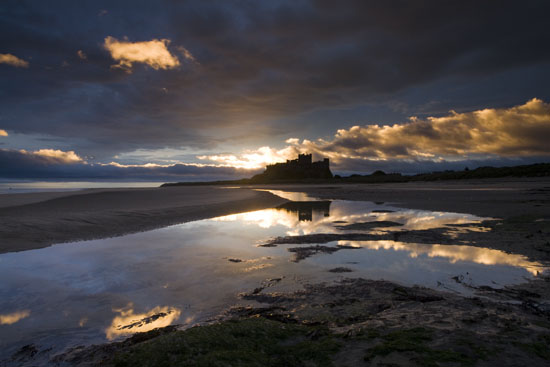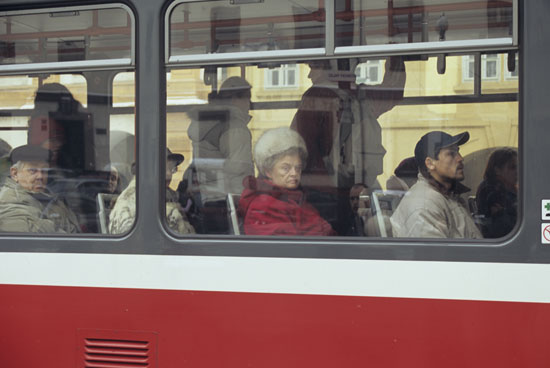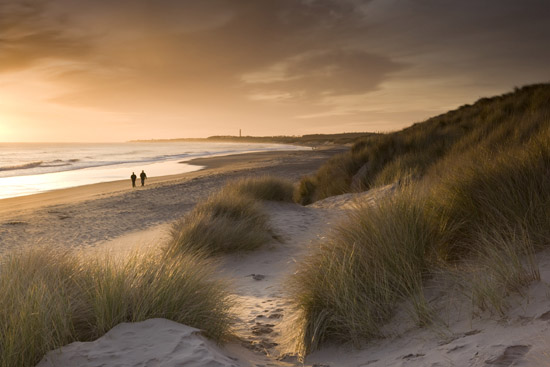Since November I have been working on a commissioned project, photographing the landscapes of Northumbria. This is my bread and butter commercial work, and is not often featured on this blog.
This commission has made me reconsider why I almost stopped outdoor work around three years ago. It has also reminded me that it is easy to take the lot we have for granted, and that my day job is a pretty good one. And at 7.30am on the beach at Bamburgh, I considered that the miles of deserted apricot coloured sands ahead of me were a pretty cool office, and that I was actualy getting paid to walk along it with my tripod slung over my shoulder! Although maybe it was just the euphoria of actually being paid for landscape work?
Apart from the joy of 4.30am alarm calls, I have been reminded that the part of the photographic process I really enjoy is the moment at which the elements and nature take dramatic control of whatever vista is in front of me. This is normally the point when a sunrise becomes dramatic, a shaft of sunlight bursts through a cloud, or a sequence of waves break perfectly.
I have also realised that nature does the hard bit, and the act of making the picture is a thoughtless one, merely a way of grabbing that moment; yes the picture may be considered, but it is still just a record of what I saw, and this throws up a host of questions. So how is it possible to then claim that the photo tells the viewer something about a place? Does for example, a “beautiful” colour photograph tell you anything more about a place than a simple cheap snapshot of the same location? Can it? In my mind this does not devalue the perfectly composed and printed image, but perhaps its dubious claims to “show” (or more pretentiously to “teach”) should be challenged?
Yes, the photographer has made the picture in a certain light, from a certain angle, and at a particular time, and those choices make the picture “easier” on the eye, more “beautiful”, but again surely it is merely a record? I once heard someone claim that their pictures showed the “spirit” of a place, but that was just a vain attempt to try and add weight to pretty landscape pictures, by claiming something that does not exist.
To me the thrill is in being there, feeling the bite of the wind on your face, being engulfed in the sound of the breaking waves and the seabirds. The euphoria we all feel when being in the natural environment or seeing something of natural beauty (maybe a sunset or a wild animal at close quarters) rarely translates into our pictures. How often have we been disappointed by holiday photos that don’t do justice to our memories; and how often have we said or heard things like “well it looked much better than that” or “I wish I had a better picture of it.” Once we are not physically experiencing the environment and that pleasure is removed, we look at things differently.
Perhaps I find it hard to engage with my landscape pictures because I know what it felt like to be there when the photograph was made, and then have had to deal with the change in emotions when I am faced with a two dimensional representation of that experience. I rarely enjoy my pictures after I have made them, unless they have intriguing subject matter, and editing a days shot can feel disappointing, as the pictures on my screen are never quite what I remembered.
When people view a picture of a landscape I have heard them say that they have “never seen it” looking like that, but that’s perhaps just because they haven’t seen it at 5am, or in the dramatic fleeting light than can exist at that time. Worse is that they may not have seen it through the high saturation/contrast filters that we routinely apply, and they never see it burned and dodged, with unsightly features cropped or even cloned out, fully sanitised and packed for consumption.
Perhaps the landscape is just a fictional notion, always viewed in the past tense, through rose tinted glasses that remind us of a collective history. It has to be clean and neat, it has to be non-threatening and calm, as anything else is dangerous and harmful, outside of our control. My weather pictures used to get “it’s lovely to see, but I wouldn’t want to have been there”, or “ooh it looks so cold….brrrr”. One only has to look at how anything “wild” is quickly removed from our towns and cities to see how important controlling and regulating nature and landscape has become. Our lives are all about limits and controls, often state sanctioned, so maybe the rose tinted ideal is required to remind us that something better did once exist, albeit fleeting.
Maybe I just have a problem with the way that colour dominates certain pictures, and how often pictures are considered of value just because of a certain colour. Take away the dominant colour in many images and little remains of any interest. Saying that, black and white images are often seen as passé or nostalgic, but at least that may remove the “pretty picture” tag that I struggle with. After all what makes a strong image should be the content, even though at times colour may be part of that.
To illustrate my point try blocking out the bright red at the bottom of this picture with your hand. Thankfully the strength of the ladies contemptuous stare is as bold as the colour.
As I was writing this post I came across a very relevant piece by David Parker http://www.davidparkerphotographer.com/ relating to beauty in art, which highlights some of my own personal struggles with pretty pictures.
“Beauty has been described recently by the English sculptor Grayson Perry as ‘the elephant in the room that many artists find difficult to ignore’. Beauty requires no commentary for its appreciation and no validation by a priesthood of academics…”
Parker goes on to say that “many artists remain deeply suspicious of beauty and ignore it altogether, and for fear of being misunderstood are eager to have the subtext of their ‘difficult’ work explicated rather than risk it being judged only at face value”.
So maybe I am just suspicious of the beauty within my landscape work, and soured by encounters with curators and “experts” who have described my landscape portfolio as “of no value”, “not relevant to anything related to art ”, and that old chestnut “not critically engaged”.
But bills have to be paid, even though every time I go out the door to work these questions go with me, and that proverbial elephant keeps nagging at me…..that is until the elements take over.
Happy New Year.
If you enjoyed this post please help by passing it on to anyone that you feel might be interested, and why not subscribe and get new posts delivered straight to your Inbox?




Happy New Year Roger,
I enjoyed your latest post a lot and can identify with the “elephant in the corner” problem. On a personal level I invariably find colour photographs less satisfying and therefore less enjoyable than black and white. Minor White, in a typically cryptic zen way, said something like- “It is not enough to photograph what is there, one must also photograph what else is there.” I think he made a very serious point though. Colour describes the external world too closely I think, and the slight move towards a more abstract representation allowed by monochrome images makes alternative readings, layered meanings, and more nuanced responses to that image more likely in the audience.
Colin
This post is food for thought for all of us who try to capture the atmosphere around us.
I love your black and white work but I find these colour pictures to be very sensitive and well thought out. Very interesting to hear about the so-called expert who said that your work was not “critically engaged”. Er … what does “critically engaged” mean exactly? Those who can .. do, those who can’t, criticise those who do! Ignore the critics and continue to do what you do best.
Roger,
Your post inspired me to consider art in the context of weather-photography. I came to the conclusion that being there is what matters most: http://www.geologywales.co.uk/storms/is-it-art-question.htm
Keep shooting and enjoying those storms!
All the best – John
Hi John – thanks for taking the time to respond to my words. It’s good to hear from you again, I found your blog piece thought provoking. I hope the Welsh weather throws you some wild-beauty this summer.
Best Wishes Roger